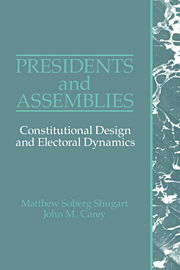Book contents
- Frontmatter
- Contents
- List of tables and figures
- Acknowledgments
- 1 Basic choices in democratic regime types
- 2 Defining regimes with elected presidents
- 3 Criticisms of presidentialism and responses
- 4 The premier-presidential and president-parliamentary experiences
- 5 The constitutional origins of chief executives
- 6 Constitutional limits on separate origin and survival
- 7 Legislative powers of presidents
- 8 Assessing the powers of the presidency
- 9 Electoral dynamics: efficiency and inefficiency
- 10 Electoral rules and the party system
- 11 Electoral cycles and the party system
- 12 Electoral cycles and compatibility between president and assembly
- 13 Conclusions
- Appendix A Electoral rules for one-seat districts and coalition-building incentives
- Appendix B Theoretical explanation for models predicting number of parties in presidential systems
- Bibliography
- Index
1 - Basic choices in democratic regime types
Published online by Cambridge University Press: 05 June 2012
- Frontmatter
- Contents
- List of tables and figures
- Acknowledgments
- 1 Basic choices in democratic regime types
- 2 Defining regimes with elected presidents
- 3 Criticisms of presidentialism and responses
- 4 The premier-presidential and president-parliamentary experiences
- 5 The constitutional origins of chief executives
- 6 Constitutional limits on separate origin and survival
- 7 Legislative powers of presidents
- 8 Assessing the powers of the presidency
- 9 Electoral dynamics: efficiency and inefficiency
- 10 Electoral rules and the party system
- 11 Electoral cycles and the party system
- 12 Electoral cycles and compatibility between president and assembly
- 13 Conclusions
- Appendix A Electoral rules for one-seat districts and coalition-building incentives
- Appendix B Theoretical explanation for models predicting number of parties in presidential systems
- Bibliography
- Index
Summary
The 1980s were a time of growth in a subfield of political science that has come to be known as the “new institutionalism” (see March and Olsen 1984; Grofman 1987). Often drawing in a matter sometimes more, sometimes less formal, from microeconomic understandings of rational behavior and individual responses to incentive structures, this subfield has placed political, rather than social or economic or cultural, variables at the center of explanation for political outcomes. There is a renewed focus on the importance of political institutions in accounting for the success or failure of democracy. Recent advances of democracy in Central and Eastern Europe and other parts of the globe have given impetus to the study of designing constitutions and the consequences of institutional choice. Old, long unchallenged assumptions about the efficacy of presidentialism in Latin America have been seriously challenged in recent years. Mindful of the spirit of resurgent interest in constitutional design, we have launched this book as a treatise on how various institutional designs for representative democracies affect the ways in which the political process operates.
This book focuses on a set of regimes that, in our assessment, have received too little attention from comparativists. It deals primarily with systems in which there is an elected president. These regimes differ from the common parliamentary type in that there are two agents of the electorate: an assembly and a president.
- Type
- Chapter
- Information
- Presidents and AssembliesConstitutional Design and Electoral Dynamics, pp. 1 - 17Publisher: Cambridge University PressPrint publication year: 1992



